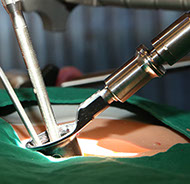feature storY
HIGHLIGHTS

What is it like to work as a spine surgeon in Pakistan? Shahzad Shamim tells his story.
Why did you choose to do spine surgery?
What attracted me to spine surgery in the first place was the magnitude of the problem in our part of the world, particularly in relation to tuberculosis. More recently, my interest "What attracted me to spine surgery was the magnitude of the problem in particular in relation to tuberculosis."has further developed, due to the constant advances in surgical technology and the growing treatment options available for spine surgeons.
Where did you do your training?
Most of my training was at the Aga Khan University Hospital in Karachi, arguably Pakistan’s top Neurosurgery center. I also did a fellowship in complex spine at the National Hospital for Neurology and Neurosurgery, London, one of the world’s oldest and most reputed Neurosurgery centers.
How do you train today and make sure you stay up-to-date?
The Internet is most definitely a great equalizer that allows anybody from any part of the "The Internet is a great equalizer that allows to stay abreast of recent advances. However, there is no substitute for hands-on workshops with subject specialists available to guide you."world to stay abreast of recent advances, by only requiring a high-speed WiFi connection. However, for true confidence ahead of major surgeries, there is no substitute for hands-on workshops with subject specialists available to guide you.
Who inspires you, or has inspired you? Who is your mentor?
My inspiration has been my father. He was an academic surgeon himself. My mentor has been Professor Ather Enam. He is the person who helped me put my first screw in the spine of a living human.
Can you share a bit in general about spine surgery in Pakistan?
Spine surgery remains underdeveloped in most parts of the country. Moreover, the standards of "The standards of treatment vary greatly from center to center. AOSpine is doing a fantastic job to standardize spine care in the country."treatment vary greatly from center to center. AOSpine is doing a fantastic job to standardize spine care in the country. Just recently, we completed a yearlong tour of different cities, to exchange ideas, and discuss principles of spine surgery.
What does your typical workday look like?
I start at seven and usually have a couple of meetings lined up for every morning, as the Chief of Services for Neurology, Neurosurgery, and Psychiatry. I do three sessions of clinic a week, and four sessions of operating, trying my best to keep the weekend free for my family.
What are your most frequent operations?
Degenerative spine, including simple decompressions and disc herniations, with one or two fixations a week. The spine service load is mixed with an equally diverse cranial workload.
What made you become involved in teaching spine surgery?
In a country marred by embarrassingly low numbers of surgeons for a massive population, it is every physician’s moral responsibility to train more and more people. The challenge is to train them well.
What are the biggest challenges in your job?
Finding the right balance between patient care, teaching, research, administration, and leaving enough time to enjoy life; to make today better than yesterday, and tomorrow better than today.
What are the differences between private practice and public health care in Pakistan?
With growing cost of healthcare, the public hospitals are lagging behind when it comes to high-quality care. Few of our public hospitals "Spine surgeons are still a rare breed. This is the right time to develop collaborations between centers for patient care, training, and research."have developed public-private partnerships with philanthropists and organizations willing to support healthcare, but in the long run, that is perhaps not a sustainable solution.
What do you consider the biggest challenges for spine surgeons in Pakistan?
The first is to be able to stay abreast with the rapidly evolving spine care around the world, and to keep state-of-the-art services affordable for our people. The second, and more difficult one, is for our spine surgeons to monitor their outcomes, and share their results in an open, transparent, and mutually beneficial academic environment.
Where do you see the biggest opportunities for spine surgeons in Karachi, and in Pakistan in general?
Spine surgeons are still a rare breed. This is the right time to develop collaborations between centers for patient care, training, and research, "AOSpine has given me a sense of belonging to something bigger. The opportunity to learn from others has had a phenomenal influence on my career, as well as on my life."before there are too many of us and it becomes impossible to bring them onto one forum. Moreover, this is also the right time to develop sub-specialty programs within the city and develop systems for timely referrals.
What advice would you give to a young surgeon?
Never stop learning.
What does being a member of AOSpine mean to you, how has AOSpine influenced your career and why would you recommend someone to become an AOSpine Member?
AOSpine has given me a sense of belonging to something bigger. The opportunity to learn AOSpine has given me a sense of belonging to something bigger. The opportunity to learn from others has had a phenomenal influence on my career, as well as on my life.from others has had a phenomenal influence on my career, as well as on my life.
AOSpine offers an unparalleled opportunity to learn from spine surgeons from around the world. The online material is just one perk of the membership. The social contact with people from all over the world, at least to me, is the most gratifying membership perk.
 Shahzad Shamim is a Consutant Neurosurgeon from the Aga Kahn University Hospital in Karachi, Pakistan
Shahzad Shamim is a Consutant Neurosurgeon from the Aga Kahn University Hospital in Karachi, Pakistan

Spine surgery in Pakistan
Newsletter 14 | December 2017